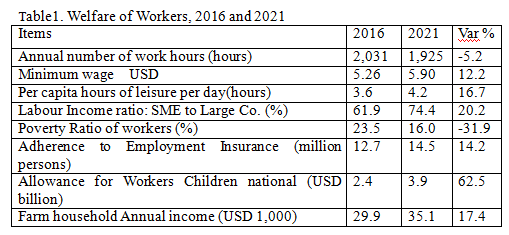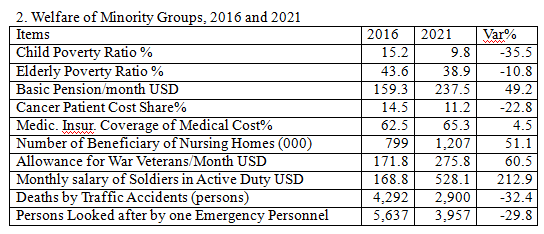He came to give the country back to the people
Joseph H. Chung (정희수), Ph.D. Professor of Economics at Quebec University in Montreal (UQAM)
(지난 호에 이어)
In Korea, between 2017 and 2021, the Gini coefficient of income distribution fell from 35 to 33. This is a sharp contrast to the Gini for asset distribution; it remained at 57. In short, President Moon was not able to affect the lopsided asset distribution, although he did better for the distribution of income.
Table 1 shows some of the measures taken by President Moon for the promotion of welfare of workers. In this table, we see two objectives of these measures, namely the increase of worker income and the improvement of the workers' life quality.
Th minimum wage increased from USD 5.26 in 2016 to USD 5.90 in 2021, a modest increase of 12.2%. The original idea was to increase it to USD 9.0 but it appeared to be too early to do so.
The farm household annual income rose in the same period from USD 29,900 to 35,100, an increase of 17.4%

The annual amount of allowance for workers' children increased from USD 2.4 billion to 3.9 billion, a rise of 62.5%.
One thing which attracts our attention is the narrowing gap between the wage of workers who work for small and medium companies (SMEs) and the wage of large company workers. In 2016, the wage at the SMEs was as low as 61.9% of wages paid by large companies. But, in 2021, wage paid by SMEs became 74.4% of wage paid by large companies. So, the gap narrowed by 20.2%
One interesting aspect is the decreasing poverty rate of workers which fell from 23.5% to 16.0%. This is indeed a great surprise.
In the same Table 1, we see also a number of measures which have improved the quality of life or lessened the cost of living.
For instance, the annual number of work hours fell from 2,031 hours to 1,925 hours or a fall of 5.2%. As a result, the leisure hours available per day was made to rise from 3.6 hours to 4.2 hours, an increase of 16.7%.The number of employment insurance adherence rose by 14.2%.
Thus, President Moon has made important contribution to the welfare of the workers and farmers.
Table 2 below gives us an idea on the improvement of the welfare of minority groups
First of all, what strikes us is the sharp fall in the poverty rate of children and the elderly. The poverty rate of children decreased by 35.5% in the period, 2016-2021, while that of the elderly fell by 10.8%. The amount of the basic pension rose from USD 159.3 to USD 237.5 per month, an increase of 49.2%. This is indeed a surprise for all.

The medical cost coverage paid by cancer patients fell by 22.8%. The overall medical coverage ratio increase from 62.5% to 65.3%, an increase of 4.5%
On the other hand, the number of beneficiary of nursing homes increased dramatically from 799,000 to 1,207,000 a jump of 51.1%.
The monthly allowance for war veterans rose from USD 171.8 to USD 275.8, an improvement of as much as 60.5%. What is more impressive is the increase in monthly payment for soldiers in active duty from USD 168.8 to USD 528.1, an increase of 212.9%
All these measures have certainly led to more money to spend and strengthen the domestic demand for goods and services thus contributing to the growth of the economy.
President Moon was much concerned with the safety of the people. For instance, the annual number of death by traffic accidents came down from 4,292 cases to 2,900 cases, a decrease of 32.4%.
Moreover, the number of persons whom a safety-related civil servant has to look after fell from 5,637 to 3,957, a fall of 29.8%.
4. New Economic System
For last four decades, the Korean economic system has been the regime of neo-liberal economic system.
Korea needed a new economic system based on the development of SMEs, better integration of the SMEs into the Chaebol-led production chain, diversification of products to be exported and the expansion of export market including the ASEAN countries and the Northern countries
In Korea, there are 6.6 million SMEs in 2018. They account for as much as 99% of the number of enterprises, create more than 80% of jobs, account for 20% of GDP .and 18% of exports.
President Moon promoted the Bureau of SMEs to the status of Ministry of Small and Medium Venture Enterprises (SMVEs) with a competent minister Park Young-sun to run it.
Table 3 shows President's strategy of structural change in exports as well as the promotion of SMEs' exports.
In the period, 2016-2021, the overall exports rose by 6.6%, but, SMES' exports increased by 9.3%.
The exports of weapons had an increase of 133.3%. Korea is becoming a significant weapon exporter. (다음 호에 계속)